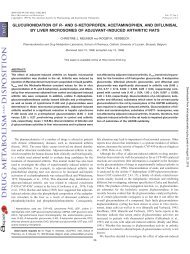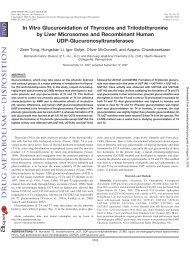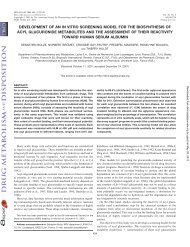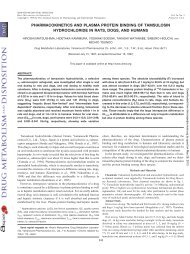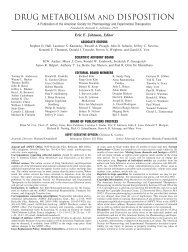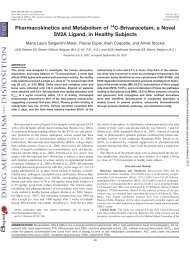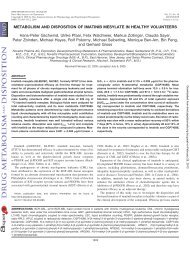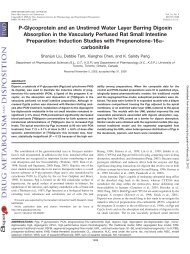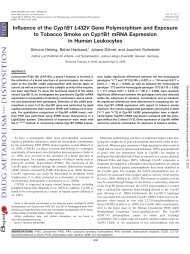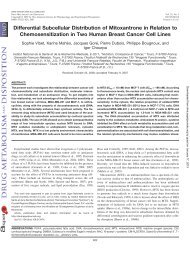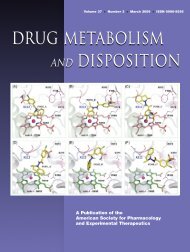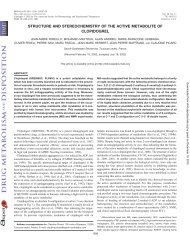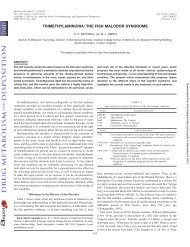role of furanocoumarin derivatives on grapefruit juice-mediated ...
role of furanocoumarin derivatives on grapefruit juice-mediated ...
role of furanocoumarin derivatives on grapefruit juice-mediated ...
Create successful ePaper yourself
Turn your PDF publications into a flip-book with our unique Google optimized e-Paper software.
0090-9556/00/2807-0766–771$03.00/0<br />
DRUG METABOLISM AND DISPOSITION Vol. 28, No. 7<br />
Copyright © 2000 by The American Society for Pharmacology and Experimental Therapeutics Printed in U.S.A.<br />
DMD 28:766–771, 2000 /1871/833869<br />
ROLE OF FURANOCOUMARIN DERIVATIVES ON GRAPEFRUIT JUICE-MEDIATED<br />
INHIBITION OF HUMAN CYP3A ACTIVITY<br />
LIAN-QING GUO, KATSUYUKI FUKUDA, TOMIHISA OHTA, AND YASUSHI YAMAZOE<br />
Divisi<strong>on</strong> <str<strong>on</strong>g>of</str<strong>on</strong>g> Drug Metabolism and Molecular Toxicology, Graduate School <str<strong>on</strong>g>of</str<strong>on</strong>g> Pharmaceutical Sciences, Tohoku University, Sendai, Japan<br />
(L.-Q.G., Y.Y.); Department <str<strong>on</strong>g>of</str<strong>on</strong>g> Drug Metabolism and Pharmacokinetics, Discovery Research Laboratory, Tanabe Seiyaku Co., Ltd, Saitama,<br />
Japan (K.F.); and Divisi<strong>on</strong> <str<strong>on</strong>g>of</str<strong>on</strong>g> Pharmacognosy and Chemistry <str<strong>on</strong>g>of</str<strong>on</strong>g> Natural Products, Faculty <str<strong>on</strong>g>of</str<strong>on</strong>g> Pharmaceutical Sciences, Kanazawa University,<br />
Kanazawa, Japan (T.O.)<br />
ABSTRACT:<br />
With <strong>juice</strong>s <str<strong>on</strong>g>of</str<strong>on</strong>g> <strong>grapefruit</strong> and related fruits, possible relati<strong>on</strong>ships<br />
between c<strong>on</strong>tents <str<strong>on</strong>g>of</str<strong>on</strong>g> six different <str<strong>on</strong>g>furanocoumarin</str<strong>on</strong>g>s and extents <str<strong>on</strong>g>of</str<strong>on</strong>g><br />
inhibiti<strong>on</strong> <str<strong>on</strong>g>of</str<strong>on</strong>g> microsomal CYP3A activity have been studied in vitro.<br />
Microsomal CYP3A-<strong>mediated</strong> testoster<strong>on</strong>e 6-hydroxylati<strong>on</strong> was<br />
inhibited by the additi<strong>on</strong> <str<strong>on</strong>g>of</str<strong>on</strong>g> a fruit <strong>juice</strong> (2.5%, v/v) from eight<br />
different <strong>grapefruit</strong> sources, two sweeties, three pomelos, and <strong>on</strong>e<br />
sour orange, whereas no clear inhibiti<strong>on</strong> was observed with two<br />
sweet orange <strong>juice</strong>s. The inhibitory comp<strong>on</strong>ent in <strong>grapefruit</strong> <strong>juice</strong><br />
resides mainly in the precipitate rather than in the supernatant<br />
after centrifugati<strong>on</strong>. Higher amounts <str<strong>on</strong>g>of</str<strong>on</strong>g> (R)-6,7-dihydroxybergamottin<br />
(DHB) were distributed in the supernatant, whereas GF-I-1,<br />
Since the first report <str<strong>on</strong>g>of</str<strong>on</strong>g> the <strong>grapefruit</strong> <strong>juice</strong> effect <strong>on</strong> the oral<br />
availability <str<strong>on</strong>g>of</str<strong>on</strong>g> felodipine (Bailey et al., 1989, 1991), <strong>grapefruit</strong> <strong>juice</strong><br />
has been shown to interact with various drugs (Ameer and Weintraub,<br />
1997; Bailey et al., 1998b; Fuhr, 1998). These drugs differ in their<br />
chemical and pharmacological properties, but are in comm<strong>on</strong> extensively<br />
metabolized by a form <str<strong>on</strong>g>of</str<strong>on</strong>g> cytochrome P450, CYP3A4. Although<br />
<strong>grapefruit</strong> <strong>juice</strong> increases the plasma drug c<strong>on</strong>centrati<strong>on</strong>, it<br />
scarcely affects the eliminati<strong>on</strong> half-lives. These results suggest that<br />
<strong>grapefruit</strong> <strong>juice</strong> mainly alters the first-pass metabolism, particularly in<br />
the small intestine. A recent study has shown that <strong>grapefruit</strong> <strong>juice</strong><br />
causes the loss <str<strong>on</strong>g>of</str<strong>on</strong>g> intestinal CYP3A4 protein without changing the<br />
specific mRNA level (Lown et al., 1997).<br />
From the high selectivity <str<strong>on</strong>g>of</str<strong>on</strong>g> <strong>grapefruit</strong> <strong>juice</strong> am<strong>on</strong>g citrus fruits, <strong>grapefruit</strong><br />
<strong>juice</strong> is believed to c<strong>on</strong>tain some specific comp<strong>on</strong>ent(s) to cause<br />
drug interacti<strong>on</strong>. Although flav<strong>on</strong>oids, such as naringin, are typical and<br />
rich comp<strong>on</strong>ents in <strong>grapefruit</strong> (Berhow et al., 1998), recent studies<br />
suggest <str<strong>on</strong>g>furanocoumarin</str<strong>on</strong>g> <str<strong>on</strong>g>derivatives</str<strong>on</strong>g> as more reas<strong>on</strong>able candidates<br />
(Fukuda et al., 1997a; Schmiedlin-Ren et al., 1997; He et al., 1998). All<br />
the <str<strong>on</strong>g>furanocoumarin</str<strong>on</strong>g>s isolated from <strong>grapefruit</strong> <strong>juice</strong> c<strong>on</strong>tain a geranyloxy<br />
This study was supported in part by the Japan-China Sasagawa Medical<br />
Scholarship Foundati<strong>on</strong> (L.-Q.G.) and Rotary Y<strong>on</strong>eyama Memorial Foundati<strong>on</strong><br />
(L.-Q.G.).<br />
Send reprint requests to: Pr<str<strong>on</strong>g>of</str<strong>on</strong>g>. Yasushi Yamazoe, Divisi<strong>on</strong> <str<strong>on</strong>g>of</str<strong>on</strong>g> Drug Metabolism<br />
and Molecular Toxicology, Graduate School <str<strong>on</strong>g>of</str<strong>on</strong>g> Pharmaceutical Sciences,<br />
Tohoku University, Aramaki-Aoba, Aoba-ku, Sendai 980-8578, Japan. E-mail:<br />
yamazoe@mail.cc.tohoku.ac.jp<br />
(Received December 13, 1999; accepted April 6, 2000)<br />
This paper is available <strong>on</strong>line at http://www.dmd.org<br />
766<br />
GF-I-2, GF-I-4, and the newly isolated GF-I-5 and GF-I-6 were<br />
detected predominantly in the precipitate. Mixing <str<strong>on</strong>g>of</str<strong>on</strong>g> five representative<br />
<str<strong>on</strong>g>furanocoumarin</str<strong>on</strong>g>s at their detectable levels in <strong>grapefruit</strong> <strong>juice</strong><br />
reproduced roughly the inhibitory potencies <str<strong>on</strong>g>of</str<strong>on</strong>g> <strong>grapefruit</strong> <strong>juice</strong>, but<br />
omissi<strong>on</strong> <str<strong>on</strong>g>of</str<strong>on</strong>g> any <str<strong>on</strong>g>of</str<strong>on</strong>g> the comp<strong>on</strong>ents resulted in decreased potencies.<br />
These results suggested that all the major <str<strong>on</strong>g>furanocoumarin</str<strong>on</strong>g>s<br />
c<strong>on</strong>tributed to the CYP3A inhibitory properties <str<strong>on</strong>g>of</str<strong>on</strong>g> <strong>grapefruit</strong> <strong>juice</strong>.<br />
Furthermore, all six <str<strong>on</strong>g>furanocoumarin</str<strong>on</strong>g>s showed str<strong>on</strong>ger CYP3A inhibitory<br />
potencies after preincubati<strong>on</strong> in the presence <str<strong>on</strong>g>of</str<strong>on</strong>g> NADPH,<br />
suggesting that both competitive and mechanism-based inhibiti<strong>on</strong><br />
occur in a <strong>grapefruit</strong> <strong>juice</strong>s-drug interacti<strong>on</strong>.<br />
side chain(s). Bergamottin (GF-I-2) 1 and (R)-6,7-dihydroxybergamottin<br />
(DHB) are the main <str<strong>on</strong>g>furanocoumarin</str<strong>on</strong>g> comp<strong>on</strong>ents, whereas two minor<br />
comp<strong>on</strong>ents 4-[[6-hydroxy-7-[[1-[(1-hydroxy-1-methyl)ethyl]-4-methyl-<br />
6-(7-oxo-7H-furo[3,2-g][1]benzopyran-4-yl)-4-hexenyl]oxy]-3,7dimethyl-2-octenyl]oxy]-7H-furo[3,2-g][1]benzopyran-7-<strong>on</strong>e<br />
(GF-I-1)<br />
and 4-[[6-hydroxy-7-[[4-methyl-1-(1-methylethenyl)-6-(7-oxo-7Hfuro[3,2-g][1]benzopyran-4-yl)-4-hexenyl]oxy]-3,7-dimethyl-2-octenyl]oxy]-7H-furo[3,2-g][1]benzopyran-7-<strong>on</strong>e<br />
(GF-I-4) are over 100 times<br />
str<strong>on</strong>ger inhibitors than GF-I-2 or DHB <strong>on</strong> microsomal CYP3A4 activities.<br />
All <str<strong>on</strong>g>of</str<strong>on</strong>g> these chemicals reduce CYP3A4 activities through both<br />
competitive and mechanism-based inhibiti<strong>on</strong> mechanisms (Bellevue et<br />
al., 1997; Schmiedlin-Ren et al., 1997; He et al., 1998). Therefore, the<br />
exact <str<strong>on</strong>g>role</str<strong>on</strong>g> <str<strong>on</strong>g>of</str<strong>on</strong>g> each compound <strong>on</strong> the <strong>grapefruit</strong> <strong>juice</strong>-drug interacti<strong>on</strong><br />
remains unclear.<br />
Clinical investigati<strong>on</strong>s <str<strong>on</strong>g>of</str<strong>on</strong>g> a <strong>grapefruit</strong> <strong>juice</strong> interacti<strong>on</strong> with a certain<br />
drug sometimes gave varying or even c<strong>on</strong>tradictory results<br />
(Ameer and Weintraub, 1997). Differences in the <strong>juice</strong> compositi<strong>on</strong><br />
due to natural origin could be a possible reas<strong>on</strong> for discordant results.<br />
However, the data supporting the direct link has not been available.<br />
1 Abbreviati<strong>on</strong>s used are: GF-I-2, bergamottin; DHB, (R)-6,7-dihydroxybergamottin;<br />
GF-I-1, 4-[[6-hydroxy-7-[[1-[(1-hydroxy-1-methyl)ethyl]-4-methyl-6-(7-oxo-<br />
7H-furo[3,2-g][1]benzopyran-4-yl)-4-hexenyl]oxy]-3,7-dimethyl-2-octenyl]oxy]-<br />
7H-furo[3,2-g][1]benzopyran-7-<strong>on</strong>e; GF-I-4, 4-[[6-hydroxy-7-[[4-methyl-1-(1methylethenyl)-6-(7-oxo-7H-furo[3,2-g][1]benzopyran-4-yl)-4-hexenyl]oxy]-3,7dimethyl-2-octenyl]oxy]-7H-furo[3,2-g][1]benzopyran-7-<strong>on</strong>e;<br />
GF-I-5, (R)-bergamottin-<br />
6,7-epoxide; GF-I-6, 4-(6R,7-dihydroxy-3,7-dimethyl-2E-octen-1-yloxy)-7Hfuro[3,2-g]chromene-spiro-7R,2-(4,4-dimethyl-5R-(3-methyl-5-(7-ox<str<strong>on</strong>g>of</str<strong>on</strong>g>uro[3,2-g]chromen-4-yloxy)-3E-penten-1-yl)-1,3-dioxolane).<br />
Downloaded from<br />
dmd.aspetjournals.org by guest <strong>on</strong> April 4, 2013
Grapefruit is believed to be derived from a pomelo sweet orange<br />
hybrid (Scora, 1975). To verify whether <str<strong>on</strong>g>furanocoumarin</str<strong>on</strong>g>s are the<br />
comp<strong>on</strong>ents causing drug interacti<strong>on</strong>, various commercial <strong>juice</strong> samples<br />
from <strong>grapefruit</strong> and related citrus fruits have been tested for both<br />
their CYP3A4 inhibitory activities and compositi<strong>on</strong>s <str<strong>on</strong>g>of</str<strong>on</strong>g> <str<strong>on</strong>g>furanocoumarin</str<strong>on</strong>g>s<br />
in this study. We have also compared the inhibitory properties <str<strong>on</strong>g>of</str<strong>on</strong>g><br />
specific and rec<strong>on</strong>stituted mixtures <str<strong>on</strong>g>of</str<strong>on</strong>g> <str<strong>on</strong>g>furanocoumarin</str<strong>on</strong>g> comp<strong>on</strong>ents to<br />
assess which comp<strong>on</strong>ent or combinati<strong>on</strong> is resp<strong>on</strong>sible for the <strong>grapefruit</strong><br />
<strong>juice</strong>-drug interacti<strong>on</strong>. During the course <str<strong>on</strong>g>of</str<strong>on</strong>g> this study, two new<br />
<str<strong>on</strong>g>furanocoumarin</str<strong>on</strong>g> comp<strong>on</strong>ents were isolated, and their structures and<br />
inhibitory properties are also reported here.<br />
Materials and Methods<br />
Chemicals and Equipment. Testoster<strong>on</strong>e, 6-hydroxytestoster<strong>on</strong>e, progester<strong>on</strong>e,<br />
and 11-hydroxyprogester<strong>on</strong>e were purchased from Sigma Chemical<br />
Co., St. Louis, MO. -NADP , D-glucose 6-phosphate, and glucose 6-phosphate<br />
dehydrogenase were obtained from Oriental Yeast, Ltd., Osaka, Japan.<br />
Diethyl ether, ethyl acetate, methanol, tetrahydr<str<strong>on</strong>g>of</str<strong>on</strong>g>uran, perchloric acid (60%,<br />
w/v), as well as other reagents <str<strong>on</strong>g>of</str<strong>on</strong>g> analytical grade were obtained from Wako<br />
Pure Chemical Industries, Ltd., Osaka, Japan. Dei<strong>on</strong>ized water was additi<strong>on</strong>ally<br />
filtered with Millipore GS 0.22 before use for HPLC.<br />
The HPLC system c<strong>on</strong>sisted <str<strong>on</strong>g>of</str<strong>on</strong>g> a PU-980 model pump and a PU-970<br />
UV/VIS model detector (Jasco Corp., Tokyo, Japan), a 712 model autosampler<br />
(Waters, Divisi<strong>on</strong> <str<strong>on</strong>g>of</str<strong>on</strong>g> Millipore, Milford, MA), and a 21J model chromatograph<br />
integrator (System Instruments Co., Ltd., Tokyo, Japan).<br />
Standards <str<strong>on</strong>g>of</str<strong>on</strong>g> Furanocoumarins. DHB, GF-I-1, GF-I-2, GF-I-4, and<br />
4-(6R,7-dihydroxy-3,7-dimethyl-2E-octen-1-yloxy)-7H-furo[3,2-g]chromenespiro-7R,2-(4,4-dimethyl-5R-(3-methyl-5-(7-oxo-furo[3,2-g]chromen-4yloxy)-3E-penten-1-yl)-1,3-dioxolane)<br />
(GF-I-6) were isolated from <strong>grapefruit</strong><br />
<strong>juice</strong>, (R)-bergamottin-6,7-epoxide (GF-I-5) was isolated from<br />
<strong>grapefruit</strong> peel oil, using a method previously reported (Fukuda et al., 1997a)<br />
with some modificati<strong>on</strong>s. Details <strong>on</strong> their stereostructures, including the newly<br />
isolated GF-I-5 and GF-I-6, have been presented at a c<strong>on</strong>ference (Ohta et al.,<br />
1999) and will be published elsewhere. Their structures are shown in Fig. 1.<br />
The isolated <str<strong>on</strong>g>furanocoumarin</str<strong>on</strong>g>s were identified by the comparis<strong>on</strong> <str<strong>on</strong>g>of</str<strong>on</strong>g> their<br />
HPLC retenti<strong>on</strong> times (described later) and UV absorpti<strong>on</strong> (Table 1) with<br />
authentic samples. Other physical informati<strong>on</strong> is available elsewhere (Edwards<br />
et al., 1996; Fukuda et al., 1997a; Ohta et al., 1999).<br />
Samples <str<strong>on</strong>g>of</str<strong>on</strong>g> Juices. Juice samples <str<strong>on</strong>g>of</str<strong>on</strong>g> <strong>grapefruit</strong> and other citrus fruits were<br />
obtained from local commercial sources and their available informati<strong>on</strong> is<br />
shown in Table 2. All the <strong>juice</strong> samples were kept at 4°C and tested so<strong>on</strong> after<br />
the <strong>juice</strong> packages were opened or after the fruits were squeezed. Some typical<br />
samples were kept at 20°C for more analyses.<br />
Analysis <str<strong>on</strong>g>of</str<strong>on</strong>g> Furanocoumarins in Juice Samples. Grapefruit <strong>juice</strong> (0.5 ml)<br />
was mixed with 10 l <str<strong>on</strong>g>of</str<strong>on</strong>g> 0.1 M progester<strong>on</strong>e (an internal standard, dissolved<br />
in methanol) and extracted three times with 0.75 ml <str<strong>on</strong>g>of</str<strong>on</strong>g> cold diethyl ether. The<br />
ether phase was separated after a vigorous vortex mixing for 3 min and<br />
centrifugati<strong>on</strong> at 5000 rpm for 1 min, and then evaporated in a centrifugal<br />
c<strong>on</strong>centrator. The residues were dissolved in 0.2 ml <str<strong>on</strong>g>of</str<strong>on</strong>g> methanol for HPLC<br />
analysis.<br />
The HPLC separati<strong>on</strong> was c<strong>on</strong>ducted at room temperature with a TSKgel<br />
column (ODS-80TM, 300 7.8 mm i.d.; TOSOH Corp., Tokyo, Japan),<br />
which was guarded with a ChemcoPak precolumn (Nucleosil 120-5C18, 30 <br />
4.6 mm i.d.; Chemco Scientific Co., Ltd., Osaka, Japan). A gradient <str<strong>on</strong>g>of</str<strong>on</strong>g> aqueous<br />
methanol (60–87% over 20 min; 87% for 25 min; 87–100% over 15 min;<br />
100% for 10 min) was used as the mobile phase, the flow rate was set at 1.1<br />
ml/min. The eluate was m<strong>on</strong>itored by the absorpti<strong>on</strong> at 310 nm.<br />
Under the above HPLC c<strong>on</strong>diti<strong>on</strong>s, DHB, GF-I-5, GF-I-1, GF-I-6, GF-I-2,<br />
and GF-I-4 were eluted as separate peaks at 28.4, 34.2, 53.8, 55.0, 56.8, and<br />
63.9 min, respectively, with respective limits <str<strong>on</strong>g>of</str<strong>on</strong>g> detecti<strong>on</strong> <str<strong>on</strong>g>of</str<strong>on</strong>g> 0.4, 0.03, 0.03,<br />
0.07, 0.2, and 0.03 M. Linear correlati<strong>on</strong> coefficients over .99 were obtained<br />
up to the c<strong>on</strong>centrati<strong>on</strong> <str<strong>on</strong>g>of</str<strong>on</strong>g> 80 M for DHB, 40 M for GF-I-5 and GF-I-2, 10<br />
M for GF-I-6, and 1 M for GF-I-1 and GF-I-4. The recoveries <str<strong>on</strong>g>of</str<strong>on</strong>g> all the<br />
<str<strong>on</strong>g>furanocoumarin</str<strong>on</strong>g>s at different levels were 87126% (except for GF-I-5 with<br />
recovery at 5084%). Both the within- and between-day c.v. values were<br />
under 13% for all the tested <str<strong>on</strong>g>furanocoumarin</str<strong>on</strong>g>s (except for GF-I-5, which<br />
showed a within-day c.v. <str<strong>on</strong>g>of</str<strong>on</strong>g> 32%).<br />
FURANOCOUMARINS IN GRAPEFRUIT JUICE INHIBIT CYP3A<br />
FIG. 1.Structures <str<strong>on</strong>g>of</str<strong>on</strong>g> <str<strong>on</strong>g>furanocoumarin</str<strong>on</strong>g>s in <strong>grapefruit</strong> <strong>juice</strong>.<br />
TABLE 1<br />
UV absorpti<strong>on</strong> <str<strong>on</strong>g>of</str<strong>on</strong>g> isolated <str<strong>on</strong>g>furanocoumarin</str<strong>on</strong>g>s from <strong>grapefruit</strong> <strong>juice</strong> or oil<br />
Furanocoumarin a<br />
Molecular<br />
Mass<br />
Absorpti<strong>on</strong> Peaks b<br />
767<br />
DHB 372 218, 247,<br />
nm<br />
256c , 264c , 306<br />
GF-I-5 354 218, 247, 255c , 263c , 309<br />
GF-I-1 726 217, 247, 255c , 264c , 306<br />
GF-I-6 726 243, 308<br />
GF-I-2 338 217, 247, 256c , 264 c , 307<br />
GF-I-4 708 218, 246, 254c , 263 c , 307<br />
a<br />
See Fig. 1. for chemical structures.<br />
b<br />
Samples are dissolved in methanol and scanned from 200 to 500 nm at room temperature.<br />
c<br />
Shoulder.<br />
Analyses <str<strong>on</strong>g>of</str<strong>on</strong>g> Furanocoumarins in Grapefruit Juice Precipitate and Supernatant.<br />
Grapefruit <strong>juice</strong> is readily precipitated during storage; <strong>on</strong>e sample<br />
(Ki-1) was selected to examine the partiti<strong>on</strong> <str<strong>on</strong>g>of</str<strong>on</strong>g> known <str<strong>on</strong>g>furanocoumarin</str<strong>on</strong>g>s between<br />
the precipitate and supernatant.<br />
Grapefruit <strong>juice</strong> (1.0 ml) was centrifuged at 15,000 rpm for 1 h. The<br />
precipitate was resuspended with dei<strong>on</strong>ized water by s<strong>on</strong>icati<strong>on</strong> <strong>on</strong> ice for 10 s.<br />
For the comparis<strong>on</strong>, the supernatant was also s<strong>on</strong>icated <strong>on</strong> ice for 10 s. Then<br />
aliquots (0.5 ml) <str<strong>on</strong>g>of</str<strong>on</strong>g> both precipitate and supernatant were treated in parallel<br />
similar to normal <strong>juice</strong> samples for <str<strong>on</strong>g>furanocoumarin</str<strong>on</strong>g> quantificati<strong>on</strong>.<br />
Preparati<strong>on</strong> <str<strong>on</strong>g>of</str<strong>on</strong>g> Microsomes. Pieces <str<strong>on</strong>g>of</str<strong>on</strong>g> human liver sample were homogenized<br />
with three volumes <str<strong>on</strong>g>of</str<strong>on</strong>g> ice-cold 1.15% KCl using a Tefl<strong>on</strong> glass<br />
homogenizer. The homogenate was centrifuged at 9000g for 20 min, and then<br />
the supernatant was transferred and centrifuged again at 105,000g for 60 min.<br />
The precipitate was resuspended to the original volume with ice-cold water.<br />
Downloaded from<br />
dmd.aspetjournals.org by guest <strong>on</strong> April 4, 2013
768 GUO ET AL.<br />
Fruit Origin<br />
The microsomal suspensi<strong>on</strong>s were stored in 0.5-ml aliquots at 80°C before<br />
use.<br />
Assay <str<strong>on</strong>g>of</str<strong>on</strong>g> Microsomal Testoster<strong>on</strong>e 6-Hydroxylati<strong>on</strong>. Testoster<strong>on</strong>e 6hydroxylati<strong>on</strong><br />
was used as the index <str<strong>on</strong>g>of</str<strong>on</strong>g> human liver microsomal CYP3A<br />
activity (Fukuda et al., 1997b). The reacti<strong>on</strong> was c<strong>on</strong>ducted for 20 min at 37°C<br />
in a mixture (0.5 ml) c<strong>on</strong>taining 0.2 mM testoster<strong>on</strong>e, 0.1 M Na 2HPO 4-<br />
KH 2PO 4 (pH 7.4), 4.8 mM MgCl 2, 0.256 mM -NADP , 2.56 mM glucose<br />
6-phosphate, and 0.16 I.U./ml glucose 6-phosphate dehydrogenase. An<br />
NADPH-generating system was preincubated at 37°C for 2 min before additi<strong>on</strong><br />
to the reacti<strong>on</strong> mixture. The reacti<strong>on</strong> was started by the additi<strong>on</strong> <str<strong>on</strong>g>of</str<strong>on</strong>g> liver<br />
microsomes (0.14 mg protein/ml), and then terminated by the additi<strong>on</strong> <str<strong>on</strong>g>of</str<strong>on</strong>g> ethyl<br />
acetate (1.0 ml). To the mixture 5 nmol <str<strong>on</strong>g>of</str<strong>on</strong>g> 11-hydroxyprogester<strong>on</strong>e was also<br />
added at the end <str<strong>on</strong>g>of</str<strong>on</strong>g> incubati<strong>on</strong> as an internal standard. The organic phase after<br />
the extracti<strong>on</strong> was transferred and dried under a gentle nitrogen flow, the<br />
resultant residue was dissolved with 0.2 ml <str<strong>on</strong>g>of</str<strong>on</strong>g> HPLC mobile phase, and an<br />
aliquot (40 l) was injected <strong>on</strong>to the HPLC column.<br />
An isocratic HPLC separati<strong>on</strong> (Sanwald et al., 1995) was c<strong>on</strong>ducted with an<br />
ODS column (LC-18DB, 5 m, 150 4.6 mm i.d.; Supelco Inc., Bellef<strong>on</strong>te,<br />
PA), guarded with a precolumn (Nucleosil 120-5C18, 5 m, 23 4.0 mm i.d.;<br />
Chemco Scientific Co., Ltd., Osaka, Japan), and a mobile phase <str<strong>on</strong>g>of</str<strong>on</strong>g> methanol<br />
(including 10% 15 mM NaClO 4, pH 2.5)/water/tetrahydr<str<strong>on</strong>g>of</str<strong>on</strong>g>uran (42:53:5) at a<br />
flow rate <str<strong>on</strong>g>of</str<strong>on</strong>g> 1.0 ml/min. The wavelength was set at 240 nm for the detecti<strong>on</strong><br />
<str<strong>on</strong>g>of</str<strong>on</strong>g> 6-hydroxytestoster<strong>on</strong>e.<br />
Inhibitory Effect <str<strong>on</strong>g>of</str<strong>on</strong>g> Grapefruit and Some Other Citrus Fruit Juices.<br />
Grapefruit <strong>juice</strong> (12.5 l) was dried with a centrifugal c<strong>on</strong>centrator and<br />
resuspended in the reacti<strong>on</strong> mixture (0.5 ml) described above. Its inhibitory<br />
effect <strong>on</strong> testoster<strong>on</strong>e 6-hydroxylati<strong>on</strong> was expressed as a percentage <str<strong>on</strong>g>of</str<strong>on</strong>g> the<br />
residual activity compared with the c<strong>on</strong>trol. Other citrus fruit <strong>juice</strong>s were also<br />
tested in a way similar to <strong>grapefruit</strong> <strong>juice</strong>.<br />
Inhibitory Effects <str<strong>on</strong>g>of</str<strong>on</strong>g> Grapefruit Juice Precipitate and Supernatant. To<br />
assess the difference <str<strong>on</strong>g>of</str<strong>on</strong>g> inhibitory effects between <strong>grapefruit</strong> <strong>juice</strong> supernatant<br />
and precipitate fracti<strong>on</strong>s, 12.5-l aliquots <str<strong>on</strong>g>of</str<strong>on</strong>g> the supernatant and the resuspended<br />
precipitate <str<strong>on</strong>g>of</str<strong>on</strong>g> Ki-1 were separately tested in the above reacti<strong>on</strong> mixture<br />
(0.5 ml). In additi<strong>on</strong>, the inhibitory effects <str<strong>on</strong>g>of</str<strong>on</strong>g> the supernatant and precipitate<br />
were also tested after ether extracti<strong>on</strong>. For this purpose, 5 l <str<strong>on</strong>g>of</str<strong>on</strong>g> the 0.2-ml<br />
methanolic soluti<strong>on</strong>s <str<strong>on</strong>g>of</str<strong>on</strong>g> their ether extracts (corresp<strong>on</strong>ding to 12.5 l <str<strong>on</strong>g>of</str<strong>on</strong>g> <strong>juice</strong>)<br />
were introduced into the reacti<strong>on</strong> mixture.<br />
Inhibitory Effects <str<strong>on</strong>g>of</str<strong>on</strong>g> Isolated Furanocoumarins. DHB, GF-I-5, GF-I-1,<br />
GF-I-6, GF-I-2, and GF-I-4 were added as a methanolic soluti<strong>on</strong> separately to<br />
the reacti<strong>on</strong> mixture to form final c<strong>on</strong>centrati<strong>on</strong>s from 10 nM to 100 M. The<br />
IC 50 values (c<strong>on</strong>centrati<strong>on</strong> <str<strong>on</strong>g>of</str<strong>on</strong>g> inhibitor causing 50% inhibiti<strong>on</strong> <str<strong>on</strong>g>of</str<strong>on</strong>g> enzyme<br />
activity) <str<strong>on</strong>g>of</str<strong>on</strong>g> these <str<strong>on</strong>g>furanocoumarin</str<strong>on</strong>g>s were determined by comparis<strong>on</strong> with the<br />
c<strong>on</strong>trols (methanol).<br />
To investigate the combined effect <str<strong>on</strong>g>of</str<strong>on</strong>g> these <str<strong>on</strong>g>furanocoumarin</str<strong>on</strong>g>s, these chemicals<br />
were added to the reacti<strong>on</strong> mixture (0.5 ml) at two levels, the highest and<br />
TABLE 2<br />
Available informati<strong>on</strong> about the <strong>juice</strong> samples used in this study<br />
Maker/Local<br />
Name<br />
Juice Package Processing Code<br />
Grapefruit<br />
White Israel Joker 1 liter, glass/F a Rec<strong>on</strong>stituted Jo<br />
White U.S. Tropicana-Kirin 1 liter, paper/J b Rec<strong>on</strong>stituted Ki<br />
White U.S. Kagome 160 g, can/J Rec<strong>on</strong>stituted Kag<br />
White Australia Berri 2 liters, plastic Rec<strong>on</strong>stituted Ber<br />
White U.S. Itoen 160 g, can/J 10% pulp Ito<br />
White U.S. Bluebird 1.36 liter, can Straight BbW<br />
Pink U.S. Bluebird 1.36 liter, can Straight BbP<br />
Sweetie Israel Jaffa Fruit Squeezed Sw<br />
Pomelo<br />
White Japan Tosa-buntan Fruit Squeezed ToB<br />
White Thailand Som-oh Fruit Squeezed SoW<br />
Pink Thailand Som-oh Fruit Squeezed SoP<br />
Orange<br />
Sour Japan Daidai Fruit Squeezed Dd<br />
Sweet U.S. Bluebird 177 ml, can Straight BbO<br />
Sweet Brazil Calpis 160 g, can/J Rec<strong>on</strong>stituted CalO<br />
a /F, the final package was made in France.<br />
b /J, the final package was made in Japan.<br />
lowest amounts in commercial <strong>grapefruit</strong> <strong>juice</strong>s. The experiments were c<strong>on</strong>ducted<br />
in different ways <str<strong>on</strong>g>of</str<strong>on</strong>g> combinati<strong>on</strong>. GF-I-6 was not included in this<br />
experiment because it was detected in <strong>on</strong>ly some, but not all, <str<strong>on</strong>g>of</str<strong>on</strong>g> the <strong>grapefruit</strong><br />
samples.<br />
Preincubati<strong>on</strong> Effect <str<strong>on</strong>g>of</str<strong>on</strong>g> Grapefruit Juice and Isolated Furanocoumarins.<br />
As an index <str<strong>on</strong>g>of</str<strong>on</strong>g> a mechanism-based inhibiti<strong>on</strong>, <strong>grapefruit</strong> <strong>juice</strong> or isolated<br />
<str<strong>on</strong>g>furanocoumarin</str<strong>on</strong>g> was preincubated for 15 min in the reacti<strong>on</strong> mixture c<strong>on</strong>taining<br />
microsomes and an NADPH-generating system before additi<strong>on</strong> <str<strong>on</strong>g>of</str<strong>on</strong>g> testoster<strong>on</strong>e.<br />
Two levels <str<strong>on</strong>g>of</str<strong>on</strong>g> testoster<strong>on</strong>e (0.2 and 1.0 mM) were used in this<br />
experiment to assess the c<strong>on</strong>centrati<strong>on</strong> effect <str<strong>on</strong>g>of</str<strong>on</strong>g> the substrate.<br />
Results<br />
Furanocoumarins in Grapefruit and Other Citrus Fruit Juices.<br />
C<strong>on</strong>centrati<strong>on</strong>s <str<strong>on</strong>g>of</str<strong>on</strong>g> six different <str<strong>on</strong>g>furanocoumarin</str<strong>on</strong>g>s were determined<br />
am<strong>on</strong>g <strong>juice</strong>s from <strong>grapefruit</strong> and related fruits (Table 3). Clear<br />
variati<strong>on</strong>s in c<strong>on</strong>centrati<strong>on</strong>s were observed up to 43-fold for DHB,<br />
36-fold for GF-I-6, 14-fold for GF-I-1, 4.1-fold for GF-I-2, and<br />
5.2-fold for GF-I-4. No clear difference was observed <strong>on</strong> GF-I-5<br />
levels am<strong>on</strong>g <strong>grapefruit</strong> <strong>juice</strong> samples, but its instability precluded<br />
accurate determinati<strong>on</strong>. At a level <str<strong>on</strong>g>of</str<strong>on</strong>g> 2.5% in reacti<strong>on</strong> mixture (12.5 l<br />
in 0.5 ml), all the <strong>grapefruit</strong> <strong>juice</strong>s significantly inhibited human<br />
microsomal CYP3A-<strong>mediated</strong> 6-hydroxylati<strong>on</strong> <str<strong>on</strong>g>of</str<strong>on</strong>g> testoster<strong>on</strong>e, to 40<br />
to 70% <str<strong>on</strong>g>of</str<strong>on</strong>g> the c<strong>on</strong>trol activity (Table 3).<br />
Grapefruit <strong>juice</strong>s such as Jo or Ki-1, c<strong>on</strong>taining relatively high<br />
amounts <str<strong>on</strong>g>of</str<strong>on</strong>g> <str<strong>on</strong>g>furanocoumarin</str<strong>on</strong>g>s, showed str<strong>on</strong>ger inhibiti<strong>on</strong> than did the<br />
other <strong>juice</strong>s such as BbP. No linear relati<strong>on</strong>ship was, however, observed<br />
between the extents <str<strong>on</strong>g>of</str<strong>on</strong>g> inhibiti<strong>on</strong> and specific c<strong>on</strong>tent <str<strong>on</strong>g>of</str<strong>on</strong>g> each<br />
<str<strong>on</strong>g>furanocoumarin</str<strong>on</strong>g>.<br />
Am<strong>on</strong>g citrus fruits other than <strong>grapefruit</strong>, sweetie <strong>juice</strong> showed a<br />
pr<str<strong>on</strong>g>of</str<strong>on</strong>g>ile similar to <strong>grapefruit</strong> <strong>juice</strong> for both <str<strong>on</strong>g>furanocoumarin</str<strong>on</strong>g> compositi<strong>on</strong><br />
and CYP3A inhibiti<strong>on</strong>. As shown in Table 3, a sample (Sw-1)<br />
c<strong>on</strong>taining higher levels <str<strong>on</strong>g>of</str<strong>on</strong>g> DHB, GF-I-1, GF-I-6, and GF-I-2, showed<br />
str<strong>on</strong>ger inhibiti<strong>on</strong> than did another sample (Sw-2). Pomelo and sour<br />
orange <strong>juice</strong>s also inhibited the CYP3A activity, but their <str<strong>on</strong>g>furanocoumarin</str<strong>on</strong>g><br />
compositi<strong>on</strong>s differed from that <str<strong>on</strong>g>of</str<strong>on</strong>g> <strong>grapefruit</strong> <strong>juice</strong>.<br />
N<strong>on</strong>e <str<strong>on</strong>g>of</str<strong>on</strong>g> the six <str<strong>on</strong>g>furanocoumarin</str<strong>on</strong>g>s were detected in two sweet orange<br />
<strong>juice</strong> samples. C<strong>on</strong>sistent with these results, sweet orange <strong>juice</strong> had no<br />
clear effect <strong>on</strong> the CYP3A activity (CalO) or inhibited it marginally<br />
(BbO).<br />
Distributi<strong>on</strong> <str<strong>on</strong>g>of</str<strong>on</strong>g> Furanocoumarins in Grapefruit Juice Supernatant<br />
and Precipitate. Grapefruit <strong>juice</strong> sample Ki-1 c<strong>on</strong>tained 33.2 <br />
1.2 g/liter <str<strong>on</strong>g>of</str<strong>on</strong>g> the precipitate. The determined quantities <str<strong>on</strong>g>of</str<strong>on</strong>g> GF-I-5,<br />
Downloaded from<br />
dmd.aspetjournals.org by guest <strong>on</strong> April 4, 2013
Code a<br />
TABLE 3<br />
Furanocoumarins in <strong>grapefruit</strong> and other citrus fruit <strong>juice</strong>s and their inhibitory effects <strong>on</strong> CYP3A activity<br />
GF-I-1, GF-I-6, GF-I-2, and GF-I-4 in Ki-1 precipitate were, respectively,<br />
1.5-, 14-, 13-, 5.4-, and 8.0-fold higher than those in Ki-1<br />
supernatant. In c<strong>on</strong>trary, DHB was 2.6-fold higher in the supernatant<br />
than in the precipitate.<br />
The inhibitory effect <str<strong>on</strong>g>of</str<strong>on</strong>g> <strong>grapefruit</strong> <strong>juice</strong> (Ki-1) precipitate was<br />
significantly str<strong>on</strong>ger than that <str<strong>on</strong>g>of</str<strong>on</strong>g> the supernatant, showing similar<br />
potency to Ki-1 without centrifugati<strong>on</strong> (Fig. 2). Similar results were<br />
obtained with the ether extracts <str<strong>on</strong>g>of</str<strong>on</strong>g> Ki-1 and its precipitate and supernatant,<br />
but larger data deviati<strong>on</strong>s appeared.<br />
Inhibiti<strong>on</strong> <str<strong>on</strong>g>of</str<strong>on</strong>g> CYP3A Activity by Isolated Furanocoumarins.<br />
The IC 50 values <str<strong>on</strong>g>of</str<strong>on</strong>g> the isolated <str<strong>on</strong>g>furanocoumarin</str<strong>on</strong>g>s <strong>on</strong> CYP3A activity<br />
were calculated to be 2000, 670, 86, 620, 22,000, and 150 nM for<br />
DHB, GF-I-5, GF-I-1, GF-I-6, GF-I-2, and GF-I-4, respectively, <strong>on</strong><br />
the inhibiti<strong>on</strong> <str<strong>on</strong>g>of</str<strong>on</strong>g> microsomal testoster<strong>on</strong>e 6-hydroxylati<strong>on</strong> (testoster<strong>on</strong>e<br />
c<strong>on</strong>centrati<strong>on</strong>: 0.2 mM). GF-I-6 was not included in the following<br />
study because it was detected <strong>on</strong>ly in some <strong>grapefruit</strong> <strong>juice</strong> samples<br />
(Table 2).<br />
The highest c<strong>on</strong>centrati<strong>on</strong>s <str<strong>on</strong>g>of</str<strong>on</strong>g> DHB, GF-I-5, GF-I-1, GF-I-2, and<br />
GF-I-4 in <strong>grapefruit</strong> <strong>juice</strong>s were roughly 35, 0.8, 0.6, 30, and 0.55<br />
M, respectively. Therefore, their final c<strong>on</strong>centrati<strong>on</strong>s in the reacti<strong>on</strong><br />
mixture (0.5 ml) would not exceed 880, 20, 15, 750, and 14 nM,<br />
respectively, after additi<strong>on</strong> <str<strong>on</strong>g>of</str<strong>on</strong>g> the <strong>juice</strong> samples (12.5 l).<br />
When these <str<strong>on</strong>g>furanocoumarin</str<strong>on</strong>g>s were separately tested at the highest<br />
levels detected in <strong>grapefruit</strong> <strong>juice</strong>s, each (except GF-I-5) decreased<br />
about 3040% <str<strong>on</strong>g>of</str<strong>on</strong>g> CYP3A activity (Table 4). Simultaneous additi<strong>on</strong><br />
<str<strong>on</strong>g>of</str<strong>on</strong>g> all five compounds resulted in nearly 70% reducti<strong>on</strong> <str<strong>on</strong>g>of</str<strong>on</strong>g> the activity.<br />
Omitting any <strong>on</strong>e <str<strong>on</strong>g>of</str<strong>on</strong>g> the <str<strong>on</strong>g>furanocoumarin</str<strong>on</strong>g> <str<strong>on</strong>g>derivatives</str<strong>on</strong>g> (except GF-<br />
I-5) from the reacti<strong>on</strong> mixture resulted in the reducti<strong>on</strong> <str<strong>on</strong>g>of</str<strong>on</strong>g> the inhibitory<br />
potency. In additi<strong>on</strong>al experiments, the additi<strong>on</strong> <str<strong>on</strong>g>of</str<strong>on</strong>g> any two or<br />
three <str<strong>on</strong>g>of</str<strong>on</strong>g> the compounds inhibited 4764% <str<strong>on</strong>g>of</str<strong>on</strong>g> the CYP3A activity<br />
(data not shown).<br />
Based <strong>on</strong> the lowest detectable c<strong>on</strong>centrati<strong>on</strong>s <str<strong>on</strong>g>of</str<strong>on</strong>g> these <str<strong>on</strong>g>furanocoumarin</str<strong>on</strong>g>s<br />
in <strong>grapefruit</strong> <strong>juice</strong>s, their possible low level <str<strong>on</strong>g>of</str<strong>on</strong>g> final c<strong>on</strong>centrati<strong>on</strong>s<br />
in reacti<strong>on</strong> mixture would be 20, 12, 1, 180, and 2.5 nM for<br />
DHB, GF-I-5, GF-I-1, GF-I-2, and GF-I-4, respectively. Simultaneous<br />
FURANOCOUMARINS IN GRAPEFRUIT JUICE INHIBIT CYP3A<br />
Furanocoumarin in Juice b<br />
M b<br />
DHB GF-I-5 GF-I-1 GF-I-6 GF-I-2 GF-I-4<br />
Residual Percentage<br />
Activity c<br />
(Mean S.D.)<br />
Grapefruit <strong>juice</strong>s<br />
Ki-1 34.7 (1) 0.77 (1) 0.49 (2) 8.70 (1) 20.4 (2) 0.37 (2) 29.3 2.9<br />
Jo 2.3 (4) 0.64 (3) 0.60 (1) 6.15 (2) 29.6 (1) 0.53 (1) 32.7 1.7<br />
Ito 1.1 (6) 0.48 (7) 0.10 (5) UD 11.5 (6) 0.17 (6) 35.8 3.0<br />
Ber 1.2 (5) 0.60 (4) 0.23 (4) UD 20.3 (3) 0.31 (4) 37.3 2.1<br />
Ki-2 14.1 (2) 0.65 (2) 0.36 (3) 3.46 (3) 14.5 (4) 0.35 (3) 43.0 2.3<br />
BbW 0.8 (7) 0.52 (6) 0.09 (6) 0.24 (4) 13.9 (5) 0.21 (5) 46.0 0.5<br />
Kag 6.0 (3) 0.56 (5) UD UD 10.8 (7) 0.11 (7) 49.1 2.9<br />
BbP UD 0.48 (7) 0.04 (7) UD 7.2 (8) 0.10 (8) 57.6 4.3<br />
Sweetie <strong>juice</strong>s<br />
Sw-1 49.5 2.59 0.28 8.05 43.09 0.51 20.2 1.7<br />
Sw-2 9.6 3.48 0.09 1.65 9.40 0.50 64.1 0.3<br />
Pomelo <strong>juice</strong>s<br />
ToB 1.9 0.87 UD UD 0.70 0.06 45.8 2.0<br />
SoW 1.0 UD 0.16 0.54 1.36 0.61 37.2 1.1<br />
SoP 0.8 UD UD UD 0.50 0.35 52.2 3.7<br />
Sour orange <strong>juice</strong><br />
Dd 10.3 1.39 0.04 0.23 0.80 0.06 57.9 6.2<br />
Sweet orange <strong>juice</strong>s<br />
BbO UD UD UD UD UD UD 75.5 5.1<br />
CalO UD UD UD UD UD UD 98.2 5.8<br />
a See Table 2 for sample descripti<strong>on</strong>s.<br />
b Mean c<strong>on</strong>centrati<strong>on</strong> <str<strong>on</strong>g>of</str<strong>on</strong>g> triple tests for each <strong>juice</strong> sample. UD, under the limit <str<strong>on</strong>g>of</str<strong>on</strong>g> detecti<strong>on</strong>; figure in parentheses, order <str<strong>on</strong>g>of</str<strong>on</strong>g> ranking within <strong>grapefruit</strong> <strong>juice</strong>s.<br />
c Residual percentage <str<strong>on</strong>g>of</str<strong>on</strong>g> testoster<strong>on</strong>e 6-hydroxylati<strong>on</strong> by human liver microsomes when incubated with 2.5% <strong>juice</strong> sample. Data are shown as mean S.D. <str<strong>on</strong>g>of</str<strong>on</strong>g> at least three determinati<strong>on</strong>s.<br />
769<br />
FIG. 2.Inhibiti<strong>on</strong> <str<strong>on</strong>g>of</str<strong>on</strong>g> microsomal CYP3A activity by <strong>grapefruit</strong> <strong>juice</strong> (left, Origin)<br />
and the ethereal extracts (right, Extract).<br />
Ki-1 was used in this experiment; see Table 2 for sample descripti<strong>on</strong> and Table<br />
3 and text for real c<strong>on</strong>centrati<strong>on</strong>s <str<strong>on</strong>g>of</str<strong>on</strong>g> specific <str<strong>on</strong>g>furanocoumarin</str<strong>on</strong>g>s. The inhibiti<strong>on</strong> was<br />
assessed before (G) and after the centrifugati<strong>on</strong> (P, precipitate; S, supernatant). The<br />
precipitate fracti<strong>on</strong> was resuspended with water to the original volume <str<strong>on</strong>g>of</str<strong>on</strong>g> <strong>juice</strong>, and<br />
tested. Microsomal testoster<strong>on</strong>e 6-hydroxylati<strong>on</strong> was used as the marker activity.<br />
“Residual CYP3A activity” is shown as the percentage; see Materials and Methods<br />
for details. Data are shown as mean S.D. <str<strong>on</strong>g>of</str<strong>on</strong>g> at least three determinati<strong>on</strong>s. *P <br />
.05 and **P .01 as compared with G.<br />
additi<strong>on</strong> <str<strong>on</strong>g>of</str<strong>on</strong>g> all five compounds at the lowest level also resulted in the<br />
clear, but weak inhibiti<strong>on</strong> <str<strong>on</strong>g>of</str<strong>on</strong>g> CYP3A activity (Table 4).<br />
Preincubati<strong>on</strong> Effect. Amounts <str<strong>on</strong>g>of</str<strong>on</strong>g> <str<strong>on</strong>g>furanocoumarin</str<strong>on</strong>g>s corresp<strong>on</strong>ding<br />
to those in a typical <strong>grapefruit</strong> <strong>juice</strong> sample (Ki-2) were added to<br />
verify the mechanism <str<strong>on</strong>g>of</str<strong>on</strong>g> inhibiti<strong>on</strong>. Except GF-I-2, each <str<strong>on</strong>g>of</str<strong>on</strong>g> the isolated<br />
<str<strong>on</strong>g>furanocoumarin</str<strong>on</strong>g>, DHB, GF-I-5, GF-I-1, GF-I-6, or GF-I-4,<br />
showed a higher extent <str<strong>on</strong>g>of</str<strong>on</strong>g> inhibiti<strong>on</strong> after preincubati<strong>on</strong> (Fig. 3).<br />
Downloaded from<br />
dmd.aspetjournals.org by guest <strong>on</strong> April 4, 2013
770 GUO ET AL.<br />
TABLE 4<br />
Inhibiti<strong>on</strong> <str<strong>on</strong>g>of</str<strong>on</strong>g> CYP3A activity by five isolated <str<strong>on</strong>g>furanocoumarin</str<strong>on</strong>g>s<br />
Furanocoumarins are added in methanolic soluti<strong>on</strong>, and then dried before the additi<strong>on</strong> <str<strong>on</strong>g>of</str<strong>on</strong>g> other comp<strong>on</strong>ents in the reacti<strong>on</strong> mixture.<br />
Combinati<strong>on</strong> <str<strong>on</strong>g>of</str<strong>on</strong>g><br />
Furanocoumarins<br />
Inhibiti<strong>on</strong> by <strong>grapefruit</strong> <strong>juice</strong> or isolated <str<strong>on</strong>g>furanocoumarin</str<strong>on</strong>g>s tended to be<br />
str<strong>on</strong>ger at the lower level <str<strong>on</strong>g>of</str<strong>on</strong>g> testoster<strong>on</strong>e substrate 0.2 than 1 mM, but<br />
the difference was not always significant between the two c<strong>on</strong>centrati<strong>on</strong>s.<br />
Furthermore, the extent <str<strong>on</strong>g>of</str<strong>on</strong>g> inhibiti<strong>on</strong> similar to that <str<strong>on</strong>g>of</str<strong>on</strong>g> the<br />
<strong>grapefruit</strong> <strong>juice</strong> sample Ki-2 was obtained by the additi<strong>on</strong> <str<strong>on</strong>g>of</str<strong>on</strong>g> all six<br />
<str<strong>on</strong>g>furanocoumarin</str<strong>on</strong>g>s to the reacti<strong>on</strong> mixture.<br />
Discussi<strong>on</strong><br />
In this study, two new chemicals isolated from <strong>grapefruit</strong> <strong>juice</strong> or<br />
oil have been shown to inhibit microsomal CYP3A activity. According<br />
to their IC50 values, GF-I-5 is a str<strong>on</strong>ger CYP3A inhibitor than<br />
two other m<strong>on</strong>omers, DHB and GF-I-2. GF-I-6 is, in c<strong>on</strong>trast, a<br />
weaker <strong>on</strong>e than two other dimers, GF-I-1 and GF-I-4. Although the<br />
C<strong>on</strong>centrati<strong>on</strong> in Reacti<strong>on</strong> Mixture<br />
GF-I-5 GF-I-2 GF-I-4 DHB GF-I-1<br />
Residual<br />
Activity a<br />
nM %<br />
Separately at high level 20 97.6 0.8***<br />
750 70.5 7.2***<br />
14 69.3 4.5***<br />
880 63.3 1.5***<br />
15 61.4 0.7***<br />
Four at high level 20 750 14 880 38.7 0.8**<br />
20 750 14 15 38.8 0.8**<br />
20 750 880 15 37.0 1.7**<br />
20 14 880 15 35.7 2.7*<br />
750 14 880 15 30.0 0.5<br />
Five at high level 20 750 14 880 15 30.3 1.5<br />
Five at low level 12 180 2.5 20 1 76.0 5.4***<br />
a Residual activities <str<strong>on</strong>g>of</str<strong>on</strong>g> testoster<strong>on</strong>e 6-hydroxylati<strong>on</strong> by human liver microsomes are shown as percentages. Data are shown as mean S.D. <str<strong>on</strong>g>of</str<strong>on</strong>g> at least three determinati<strong>on</strong>s.<br />
* P .05, ** P .01, and *** P .001 as compared with “Five at high level”.<br />
FIG. 3.Preincubati<strong>on</strong> effects <str<strong>on</strong>g>of</str<strong>on</strong>g> <strong>grapefruit</strong> <strong>juice</strong> and isolated <str<strong>on</strong>g>furanocoumarin</str<strong>on</strong>g>s.<br />
Juice: <strong>grapefruit</strong> <strong>juice</strong> (Ki-2, see Table 2 for sample descripti<strong>on</strong> and Table 3 for the c<strong>on</strong>centrati<strong>on</strong>s <str<strong>on</strong>g>of</str<strong>on</strong>g> specific <str<strong>on</strong>g>furanocoumarin</str<strong>on</strong>g>s); FCs: rec<strong>on</strong>stituti<strong>on</strong> <str<strong>on</strong>g>of</str<strong>on</strong>g> DHB, GF-I-5,<br />
GF-I-1, GF-I-6, GF-I-2, and GF-I-4 as Ki-2; Residual CYP3A activity: the residual percentage <str<strong>on</strong>g>of</str<strong>on</strong>g> testoster<strong>on</strong>e 6-hydroxylati<strong>on</strong> by human liver microsomes; 15 or 0 min:<br />
with or without 15-min preincubati<strong>on</strong>; 0.2 or 1 mM T: 0.2 or 1.0 mM testoster<strong>on</strong>e added as a substrate. See Materials and Methods for other details. Data are shown as<br />
mean S.D. <str<strong>on</strong>g>of</str<strong>on</strong>g> at least three determinati<strong>on</strong>s. Significant differences (P .05 or P .01) were noted for the inhibiti<strong>on</strong>s <str<strong>on</strong>g>of</str<strong>on</strong>g> Juice, FCs, DHB, GF-I-1, GF-I-6, GF-I-4, or<br />
GF-I-5 with 15-min preincubati<strong>on</strong> versus those without preincubati<strong>on</strong>. GF-I-2 didn’t show obvious inhibiti<strong>on</strong> at the low c<strong>on</strong>centrati<strong>on</strong> c<strong>on</strong>diti<strong>on</strong> <str<strong>on</strong>g>of</str<strong>on</strong>g> this experiment.<br />
instability <str<strong>on</strong>g>of</str<strong>on</strong>g> GF-I-5 and the variati<strong>on</strong> in c<strong>on</strong>tents <str<strong>on</strong>g>of</str<strong>on</strong>g> GF-I-6 hampered<br />
the determinati<strong>on</strong> <str<strong>on</strong>g>of</str<strong>on</strong>g> their inhibitory properties in <strong>grapefruit</strong> <strong>juice</strong>,<br />
these newly identified <str<strong>on</strong>g>furanocoumarin</str<strong>on</strong>g>s are, in additi<strong>on</strong> to DHB,<br />
GF-I-1, GF-I-2, and GF-I-4, likely to c<strong>on</strong>tribute to the CYP3A inhibiti<strong>on</strong><br />
elicited by <strong>grapefruit</strong> <strong>juice</strong>.<br />
Grapefruit <strong>juice</strong>s differed in strains (white or pink), origin (U.S.,<br />
Australia, or Israel), packages (in glass, paper, plastic, or metal<br />
c<strong>on</strong>tainer), and ways <str<strong>on</strong>g>of</str<strong>on</strong>g> processing (rec<strong>on</strong>stituted, straight, or c<strong>on</strong>taining<br />
10% pulp) were also tested in this study (Table 2). These <strong>juice</strong>s are<br />
qualitatively similar in <str<strong>on</strong>g>furanocoumarin</str<strong>on</strong>g> compositi<strong>on</strong> (except for GF-<br />
I-6), and thus all significantly inhibit microsomal CYP3A activity<br />
(Table 3).<br />
The inhibitory potency <str<strong>on</strong>g>of</str<strong>on</strong>g> <strong>grapefruit</strong> <strong>juice</strong> would be expected to<br />
Downloaded from<br />
dmd.aspetjournals.org by guest <strong>on</strong> April 4, 2013
correlate with the c<strong>on</strong>tent <str<strong>on</strong>g>of</str<strong>on</strong>g> a single comp<strong>on</strong>ent if a specific <str<strong>on</strong>g>furanocoumarin</str<strong>on</strong>g><br />
derivative is solely resp<strong>on</strong>sible for the inhibiti<strong>on</strong> <str<strong>on</strong>g>of</str<strong>on</strong>g> CYP3A<br />
activity. The inhibitory potency <str<strong>on</strong>g>of</str<strong>on</strong>g> <strong>grapefruit</strong> <strong>juice</strong> samples (Table 3)<br />
tended to be higher with <strong>grapefruit</strong> <strong>juice</strong> c<strong>on</strong>taining higher amounts <str<strong>on</strong>g>of</str<strong>on</strong>g><br />
<str<strong>on</strong>g>furanocoumarin</str<strong>on</strong>g>s, but showed no clear correlati<strong>on</strong> with specific c<strong>on</strong>tents<br />
<str<strong>on</strong>g>of</str<strong>on</strong>g> any <strong>on</strong>e <str<strong>on</strong>g>of</str<strong>on</strong>g> the chemicals.<br />
In the fracti<strong>on</strong>ati<strong>on</strong> experiment <str<strong>on</strong>g>of</str<strong>on</strong>g> <strong>grapefruit</strong> <strong>juice</strong> Ki-1 (Fig. 2), the<br />
major inhibitory comp<strong>on</strong>ent(s) were found to reside in the precipitate<br />
rather than in the supernatant after the centrifugati<strong>on</strong>. Most <str<strong>on</strong>g>furanocoumarin</str<strong>on</strong>g><br />
<str<strong>on</strong>g>derivatives</str<strong>on</strong>g>, except for DHB, are localized in the precipitate.<br />
This phenomen<strong>on</strong> is c<strong>on</strong>sistent with the results observed in vivo<br />
(Bailey et al., 1998a; Edwards et al., 1999). These data indicate a<br />
dominant <str<strong>on</strong>g>role</str<strong>on</strong>g> <str<strong>on</strong>g>of</str<strong>on</strong>g> <str<strong>on</strong>g>furanocoumarin</str<strong>on</strong>g>s residing in the precipitate. The <str<strong>on</strong>g>role</str<strong>on</strong>g><br />
<str<strong>on</strong>g>of</str<strong>on</strong>g> DHB is, however, not denied because <str<strong>on</strong>g>of</str<strong>on</strong>g> the weak, but significant,<br />
inhibitory potency <str<strong>on</strong>g>of</str<strong>on</strong>g> the supernatant.<br />
To address the exact <str<strong>on</strong>g>role</str<strong>on</strong>g> <str<strong>on</strong>g>of</str<strong>on</strong>g> <str<strong>on</strong>g>furanocoumarin</str<strong>on</strong>g>s, rec<strong>on</strong>stituti<strong>on</strong> <str<strong>on</strong>g>of</str<strong>on</strong>g><br />
<strong>grapefruit</strong> <strong>juice</strong> with five <str<strong>on</strong>g>furanocoumarin</str<strong>on</strong>g>s has been c<strong>on</strong>ducted. As<br />
shown in Table 4, n<strong>on</strong>e <str<strong>on</strong>g>of</str<strong>on</strong>g> the <str<strong>on</strong>g>furanocoumarin</str<strong>on</strong>g>s, when added separately<br />
at the highest level observed in the <strong>juice</strong>, reached 40% inhibiti<strong>on</strong><br />
<str<strong>on</strong>g>of</str<strong>on</strong>g> microsomal CYP3A activity. The combined mixture at the<br />
highest observed levels inhibited the activity as str<strong>on</strong>gly as the str<strong>on</strong>gest<br />
<strong>grapefruit</strong> <strong>juice</strong> sample (Jo or Ki-1). Furthermore, omissi<strong>on</strong> <str<strong>on</strong>g>of</str<strong>on</strong>g><br />
any <str<strong>on</strong>g>of</str<strong>on</strong>g> the <str<strong>on</strong>g>furanocoumarin</str<strong>on</strong>g> compounds (except GF-I-5) from the<br />
mixture resulted in a reducti<strong>on</strong> <str<strong>on</strong>g>of</str<strong>on</strong>g> the inhibiti<strong>on</strong>. These results suggest<br />
that each <str<strong>on</strong>g>furanocoumarin</str<strong>on</strong>g> c<strong>on</strong>tributes to the inhibitory effect <str<strong>on</strong>g>of</str<strong>on</strong>g> <strong>grapefruit</strong><br />
<strong>juice</strong>. Although the natural c<strong>on</strong>centrati<strong>on</strong>s <str<strong>on</strong>g>of</str<strong>on</strong>g> dimers GF-I-1 and<br />
GF-I-4 in <strong>grapefruit</strong> <strong>juice</strong> are much lower than the m<strong>on</strong>omers DHB<br />
and GF-I-2, their c<strong>on</strong>tributi<strong>on</strong>s to the inhibiti<strong>on</strong> are comparable because<br />
<str<strong>on</strong>g>of</str<strong>on</strong>g> the higher inhibitory potencies <str<strong>on</strong>g>of</str<strong>on</strong>g> the dimers than the m<strong>on</strong>omers<br />
<strong>on</strong> microsomal CYP3A activity.<br />
Combined additi<strong>on</strong> <str<strong>on</strong>g>of</str<strong>on</strong>g> all five <str<strong>on</strong>g>furanocoumarin</str<strong>on</strong>g>s at their low c<strong>on</strong>centrati<strong>on</strong>s<br />
inhibited CYP3A, but the extent was weaker than observed<br />
with BbP (which c<strong>on</strong>tains a compositi<strong>on</strong> similar to the mixture<br />
<str<strong>on</strong>g>of</str<strong>on</strong>g> low level <str<strong>on</strong>g>furanocoumarin</str<strong>on</strong>g>s). The reas<strong>on</strong> for this apparent discrepancy<br />
is unclear, thus the c<strong>on</strong>tributi<strong>on</strong> <str<strong>on</strong>g>of</str<strong>on</strong>g> comp<strong>on</strong>ent(s) other than the<br />
above five <str<strong>on</strong>g>furanocoumarin</str<strong>on</strong>g>s is not excluded. A study showed that<br />
naring(en)in modulated the inhibitory effect <str<strong>on</strong>g>of</str<strong>on</strong>g> <strong>grapefruit</strong> <strong>juice</strong><br />
(Runkel et al., 1997).<br />
Interestingly, <strong>grapefruit</strong> <strong>juice</strong> Ki-2 and all the isolated <str<strong>on</strong>g>furanocoumarin</str<strong>on</strong>g>s<br />
(except GF-I-2), at c<strong>on</strong>centrati<strong>on</strong> levels similar to Ki-2,<br />
showed increased inhibiti<strong>on</strong> in the preincubati<strong>on</strong> system (Fig. 3).<br />
These results suggest at least a partial <str<strong>on</strong>g>role</str<strong>on</strong>g> for mechanism-based<br />
inhibiti<strong>on</strong> in the <strong>grapefruit</strong> <strong>juice</strong>-drug interacti<strong>on</strong>.<br />
This study suggests that all the major <str<strong>on</strong>g>furanocoumarin</str<strong>on</strong>g>s are necessary<br />
for the maximal inhibiti<strong>on</strong> <str<strong>on</strong>g>of</str<strong>on</strong>g> CYP3A activity observed in <strong>grapefruit</strong><br />
<strong>juice</strong>. The c<strong>on</strong>tributi<strong>on</strong> <str<strong>on</strong>g>of</str<strong>on</strong>g> each comp<strong>on</strong>ent varies by its inhibitory<br />
potency and natural abundance. It is obvious that the effect <str<strong>on</strong>g>of</str<strong>on</strong>g> <strong>grapefruit</strong><br />
<strong>juice</strong> <strong>on</strong> CYP3A activity is quite complicated even in vitro.<br />
Experiments with citrus fruit (other than <strong>grapefruit</strong>) that also c<strong>on</strong>tain<br />
<str<strong>on</strong>g>furanocoumarin</str<strong>on</strong>g>s supported the <str<strong>on</strong>g>role</str<strong>on</strong>g> <str<strong>on</strong>g>of</str<strong>on</strong>g> <str<strong>on</strong>g>furanocoumarin</str<strong>on</strong>g>s <strong>on</strong> the<br />
inhibitory effect toward the CYP3A activity (Tables 2 and 3). The<br />
extent <str<strong>on</strong>g>of</str<strong>on</strong>g> inhibiti<strong>on</strong> was str<strong>on</strong>ger than that <str<strong>on</strong>g>of</str<strong>on</strong>g> <strong>grapefruit</strong> with sweetie<br />
Sw-1, which c<strong>on</strong>tains high levels <str<strong>on</strong>g>of</str<strong>on</strong>g> <str<strong>on</strong>g>furanocoumarin</str<strong>on</strong>g>s. Tax<strong>on</strong>omic<br />
research showed that a cross <str<strong>on</strong>g>of</str<strong>on</strong>g> pomelo and mandarin produced sweet<br />
orange and sour orange, a cross <str<strong>on</strong>g>of</str<strong>on</strong>g> pomelo and sweet orange produced<br />
<strong>grapefruit</strong> (Scora, 1975). A cross <str<strong>on</strong>g>of</str<strong>on</strong>g> pomelo and <strong>grapefruit</strong> produced<br />
sweetie (Mort<strong>on</strong>, 1987). Thus, cauti<strong>on</strong>s may not be limited to <strong>grapefruit</strong><br />
because the existence <str<strong>on</strong>g>of</str<strong>on</strong>g> <str<strong>on</strong>g>furanocoumarin</str<strong>on</strong>g> is also related to<br />
pomelo and more than <strong>on</strong>e <str<strong>on</strong>g>of</str<strong>on</strong>g> its crossed varieties.<br />
FURANOCOUMARINS IN GRAPEFRUIT JUICE INHIBIT CYP3A<br />
Besides the Rutaceae family (like <strong>grapefruit</strong>), many plants <str<strong>on</strong>g>of</str<strong>on</strong>g> other<br />
families such as Umbelliferae, Moraceae, and Leguminosae also<br />
c<strong>on</strong>tain <str<strong>on</strong>g>furanocoumarin</str<strong>on</strong>g> <str<strong>on</strong>g>derivatives</str<strong>on</strong>g> (Pathak et al., 1962). Many <str<strong>on</strong>g>of</str<strong>on</strong>g><br />
these plants are used as comm<strong>on</strong> vegetables (Beier, 1990) or traditi<strong>on</strong>al<br />
medicines (Namba, 1980). Thus it is possible that <str<strong>on</strong>g>furanocoumarin</str<strong>on</strong>g>s<br />
c<strong>on</strong>tained in these vegetables or herbal medicines also change<br />
the pharmacokinetics <str<strong>on</strong>g>of</str<strong>on</strong>g> drugs. In fact, we have recently observed that<br />
<str<strong>on</strong>g>furanocoumarin</str<strong>on</strong>g> <str<strong>on</strong>g>derivatives</str<strong>on</strong>g> isolated from Umbelliferous crude drugs<br />
are str<strong>on</strong>g CYP3A inhibitors (Guo et al., 2000). Now we are currently<br />
working to assess the inhibitory effect <str<strong>on</strong>g>of</str<strong>on</strong>g> clinical prescripti<strong>on</strong>s that<br />
include these crude drugs.<br />
References<br />
771<br />
Ameer B and Weintraub RA (1997) Drug interacti<strong>on</strong>s with <strong>grapefruit</strong> <strong>juice</strong>. Clin Pharmacokinet<br />
33:103–121.<br />
Bailey DG, Kreeft JH, Munoz C, Freeman DJ and Bend JR (1998a) Grapefruit <strong>juice</strong>-felodipine<br />
interacti<strong>on</strong>: Effect <str<strong>on</strong>g>of</str<strong>on</strong>g> naringin and 6,7-dihydroxybergamottin in humans. Clin Pharmacol<br />
Ther 64:248–256.<br />
Bailey DG, Malcolm J, Arnold O and Spence JD (1998b) Grapefruit <strong>juice</strong>-drug interacti<strong>on</strong>s. Br J<br />
Clin Pharmacol 46:101–110.<br />
Bailey DG, Spence JD, Edgar B, Bayliff CD and Arnold JM (1989) Ethanol enhances the<br />
hemodynamic effects <str<strong>on</strong>g>of</str<strong>on</strong>g> felodipine. Clin Invest Med 12:357–362.<br />
Bailey DG, Spence JD, Munoz C and Arnold JM (1991) Interacti<strong>on</strong> <str<strong>on</strong>g>of</str<strong>on</strong>g> citrus <strong>juice</strong>s with<br />
felodipine and nifedipine. Lancet 337:268–269.<br />
Beier RC (1990) Natural pesticides and bioactive comp<strong>on</strong>ents in foods. Rev Envir<strong>on</strong> C<strong>on</strong>tam<br />
Toxicol 113:47–137.<br />
Bellevue FH, Woster PM, Edwards DJ, He K and Hollenberg PF (1997) Synthesis and biological<br />
evaluati<strong>on</strong> <str<strong>on</strong>g>of</str<strong>on</strong>g> 6,7-dihydroxybergamottin (6,7-Dhb), a naturally occurring inhibitor <str<strong>on</strong>g>of</str<strong>on</strong>g> cytochrome<br />
P450 3a4. Bioorg Med Chem Lett 7:2593–2598.<br />
Berhow M, Tisserat B, Kanes K and Vandercook C (1998) Survey <str<strong>on</strong>g>of</str<strong>on</strong>g> phenolic compounds<br />
produced in citrus. Technical Bulletin 1856. U.S. Department <str<strong>on</strong>g>of</str<strong>on</strong>g> Agriculture, Agricultural<br />
Research Service, Peoria, IL.<br />
Edwards DJ, Bellevue FH and Woster PM (1996) Identificati<strong>on</strong> <str<strong>on</strong>g>of</str<strong>on</strong>g> 6,7-dihydroxybergamottin,<br />
a cytochrome P450 inhibitor, in <strong>grapefruit</strong> <strong>juice</strong>. Drug Metab Dispos 24:1287–1290.<br />
Edwards DJ, Fitzsimm<strong>on</strong>s ME, Schuetz EG, Yasuda K, Ducharme MP, Warbasse LH, Woster<br />
PM, Schuetz JD and Watkins P (1999) 6,7-Dihydroxybergamottin in <strong>grapefruit</strong> <strong>juice</strong> and<br />
Seville orange <strong>juice</strong>: Effects <strong>on</strong> cyclosporine dispositi<strong>on</strong>, enterocyte CYP3A4, and Pglycoprotein.<br />
Clin Pharmacol Ther 65:237–244.<br />
Fuhr U (1998) Drug interacti<strong>on</strong>s with <strong>grapefruit</strong> <strong>juice</strong>. Extent, probable mechanism and clinical<br />
relevance. Drug Saf 18:251–272.<br />
Fukuda K, Ohta T, Oshima Y, Ohashi N, Yoshikawa M and Yamazoe Y (1997a) Specific<br />
CYP3A4 inhibitors in <strong>grapefruit</strong> <strong>juice</strong>: Furocoumarin dimers as comp<strong>on</strong>ents <str<strong>on</strong>g>of</str<strong>on</strong>g> drug interacti<strong>on</strong>.<br />
Pharmacogenetics 7:391–396.<br />
Fukuda K, Ohta T and Yamazoe Y (1997b) Grapefruit comp<strong>on</strong>ent interacting with rat and human<br />
P450 CYP3A: Possible involvement <str<strong>on</strong>g>of</str<strong>on</strong>g> n<strong>on</strong>-flav<strong>on</strong>oid comp<strong>on</strong>ents in drug interacti<strong>on</strong>. Biol<br />
Pharm Bull 20:560–564.<br />
Guo L-Q, Taniguchi M, Xiao Y-Q, Baba K, Ohta T and Yamazoe Y (2000) Inhibitory effect <str<strong>on</strong>g>of</str<strong>on</strong>g><br />
natural <str<strong>on</strong>g>furanocoumarin</str<strong>on</strong>g>s <strong>on</strong> human microsomal cytochrome P450 3A activity. Jpn J Pharmacol<br />
82:122–129.<br />
He K, Iyer KR, Hayes RN, Sinz MW, Woolf TF and Hollenberg PF (1998) Inactivati<strong>on</strong> <str<strong>on</strong>g>of</str<strong>on</strong>g><br />
cytochrome P450 3A4 by bergamottin, a comp<strong>on</strong>ent <str<strong>on</strong>g>of</str<strong>on</strong>g> <strong>grapefruit</strong> <strong>juice</strong>. Chem Res Toxicol<br />
11:252–259.<br />
Lown KS, Bailey DG, F<strong>on</strong>tana RJ, Janardan SK, Adair CH, Fortlage LA, Brown MB, Guo W<br />
and Watkins PB (1997) Grapefruit <strong>juice</strong> increases felodipine oral availability in humans by<br />
decreasing intestinal CYP3A protein expressi<strong>on</strong>. J Clin Invest 99:2545–2553.<br />
Mort<strong>on</strong> JF (1987) Grapefruit, in Fruits <str<strong>on</strong>g>of</str<strong>on</strong>g> Warm Climates (Mort<strong>on</strong> JF ed) pp152–158, (obtained<br />
from http://www.hort.purdue.edu/mewcrop/mort<strong>on</strong>/<strong>grapefruit</strong>.html), Miami, FL.<br />
Namba T (1980) Coloured Illustrati<strong>on</strong>s <str<strong>on</strong>g>of</str<strong>on</strong>g> Wakan-Yaku (The Crude Drugs in Japan, China and<br />
the Neighbouring Countries). (Japanese, with English indexes) Hoikusha Publishing Co.,<br />
LTD., Osaka, Japan.<br />
Ohta T, Nagahashi M, Miyamoto Y, Hosoi S, Maruyama T, Kiuchi F and Yamazoe Y (1999)<br />
Stereostructures <str<strong>on</strong>g>of</str<strong>on</strong>g> CYP3A4 inhibitors in <strong>grapefruit</strong> <strong>juice</strong>. A symposium paper <str<strong>on</strong>g>of</str<strong>on</strong>g> 41st<br />
Symposium <strong>on</strong> the Chemistry <str<strong>on</strong>g>of</str<strong>on</strong>g> Natural Products, 1999 Oct 13–15; Nagoya, Japan, pp.<br />
439–444 (with an English abstract).<br />
Pathak MA, Daniels F and Fitzpatrick TB (1962) The presently known distributi<strong>on</strong> <str<strong>on</strong>g>of</str<strong>on</strong>g> furocoumarins<br />
(psoralens) in plants. J Invest Dermatol 39:225–239.<br />
Runkel M, Bourian M, Tegtmeier M and Legrum W (1997) The character <str<strong>on</strong>g>of</str<strong>on</strong>g> inhibiti<strong>on</strong> <str<strong>on</strong>g>of</str<strong>on</strong>g> the<br />
metabolism <str<strong>on</strong>g>of</str<strong>on</strong>g> 1,2-benzopyr<strong>on</strong>e (coumarin) by <strong>grapefruit</strong> <strong>juice</strong> in human. Eur J Clin Pharmacol<br />
53:265–269.<br />
Sanwald P, Blanks<strong>on</strong> EA, Dulery BD, Schoun J, Huebert ND and Dow J (1995) Isocratic<br />
high-performance liquid chromatographic method for the separati<strong>on</strong> <str<strong>on</strong>g>of</str<strong>on</strong>g> testoster<strong>on</strong>e metabolites.<br />
J Chromatogr B 672:207–215.<br />
Schmiedlin-Ren P, Edwards DJ, Fitzsimm<strong>on</strong>s ME, He K, Lown KS, Woster PM, Rahman A,<br />
Thummel KE, Fisher JM, Hollenberg PF and Watkins PB (1997) Mechanisms <str<strong>on</strong>g>of</str<strong>on</strong>g> enhanced<br />
oral availability <str<strong>on</strong>g>of</str<strong>on</strong>g> CYP3A4 substrates by <strong>grapefruit</strong> c<strong>on</strong>stituents. Decreased enterocyte<br />
CYP3A4 c<strong>on</strong>centrati<strong>on</strong> and mechanism-based inactivati<strong>on</strong> by <str<strong>on</strong>g>furanocoumarin</str<strong>on</strong>g>s. Drug Metab<br />
Dispos 25:1228–1233.<br />
Scora RW (1975) On the history and origin <str<strong>on</strong>g>of</str<strong>on</strong>g> citrus. Bull Torrey Bot Club 102:369–375.<br />
Downloaded from<br />
dmd.aspetjournals.org by guest <strong>on</strong> April 4, 2013



